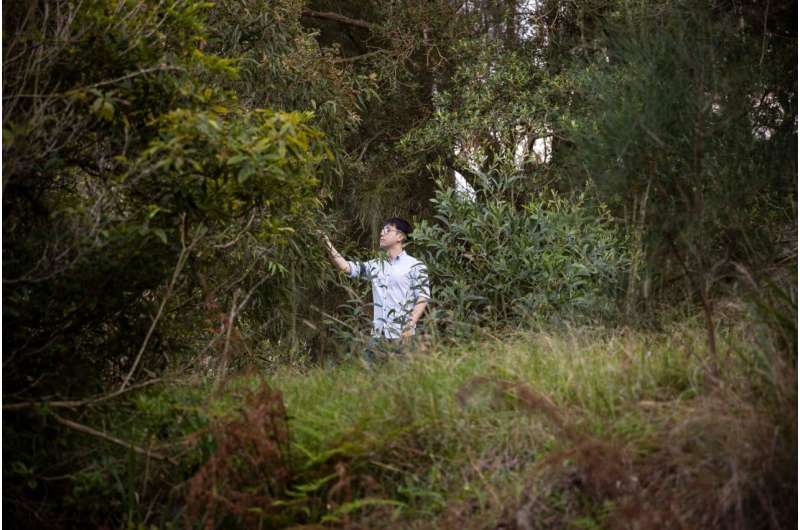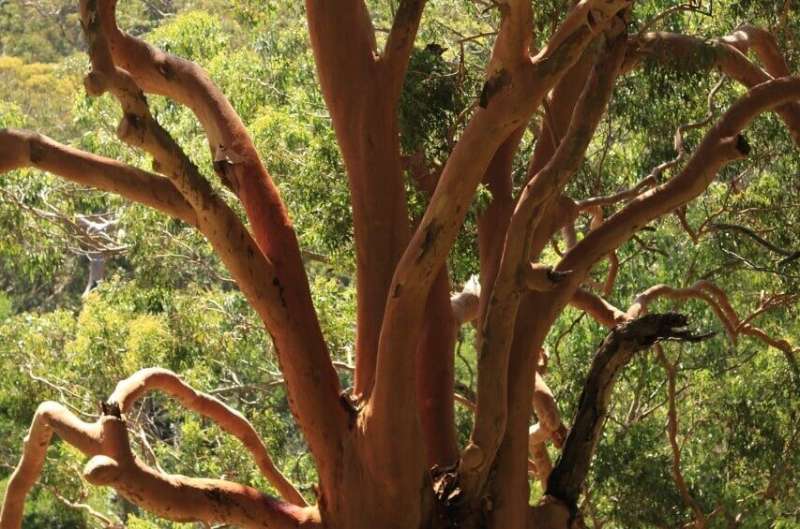This article has been reviewed according to Science X's editorial process and policies. Editors have highlighted the following attributes while ensuring the content's credibility:
fact-checked
trusted source
proofread
Plant more native trees to reduce landslide risk, control erosion, say researchers

Landslides typically occur under heavy rain. With the potential for increased precipitation due to climate change and a possible return to La Niña reinforcing slopes with native trees and shrubs could be an effective, economical and sustainable solution.
Homeowners, councils and state governments looking to build houses and infrastructure on or near slopes should reconsider cutting down trees or using artificial slope reinforcement to buttress vertical terrain against landslides and slips.
They should plant native trees and shrubs instead, says University of Sydney Ph.D. candidate and nature lover Jiale Zhu. He is researching how native trees and shrubs, common to East Coast Australia, could help reinforce sloping terrain and reduce the risk of landslide and soil erosion under wet conditions.
He found that the Sydney red gum, narrow-leaf scribbly gum, blueberry ash, coastal banksia and crimson bottlebrush were best for stabilizing shallow slopes, which are typically 2 meters deep and involve up to 1,000 square meters of soil.
"Plants provide a sustainable, natural approach to slope reinforcement, compared to artificial methods, such as steel mesh or sprayed concrete. They also create and maintain crucial habitat," said Zhu from the School of Civil Engineering.
He says the focus of his doctorate is particularly pertinent with a potential return to wet La Niña conditions and with the increasing prevalence of extreme weather events. Landslides typically occur under heavy precipitation and have the potential to rip apart homes, which occurred during the 2022 floods. Which trees are best for preventing landslides and erosion?
Out of all the species, Sydney red gums—also known as angophora—and blueberry ash were the best at slope reinforcement. Zhu said, "The robust taproot system of the Sydney red gum—where a dominant root takes hold of soil—provides an anchor against erosion. Its elastic roots also help it penetrate stiff soils, making it suitable for rocky sites or areas with deep groundwater. These conditions encourage it to lay down deep roots which further helps strengthen erosion control."
"Blueberry ash trees have a thick, vertical, heart shaped root system and, out of all the trees I studied, were the most resistant to being pulled out. They also provide berries for native birds like the regent bowerbird," he said.
While using trees to stabilize soil on shallow slopes has long been understood to be effective, few studies have focused on Australian species and conditions. According to Geoscience Australia data, incidences of landslides and heavy erosion increased by 190% in the period between 2004 and 2017, compared with the period 1990–2003.
The role of precipitation can also be difficult to understand in experimental settings. Zhu said, "It can be very hard to replicate wet conditions in field studies because it's hard to control the water content, but what we do know is landslides are more likely to occur during heavy rainfall."

The most at-risk areas
Cut out motorways, reclaimed or disused mine pits and riverbanks were most at risk of erosion and landslide during higher precipitation. Zhu believes state governments should prioritize reinforcing slopes with trees alongside state-owned assets and major river systems, and councils should prioritize in-filling terrain on public land and around housing with native species.
"Sometimes, nature offers the best solution. Prioritizing native planting would be a quicker way to achieve the NSW Government's 2036 green cover index, opening new sites for regreening that directly benefit critical infrastructure, homes and crucial river systems," he said.
Homeowners, too, should consider planting these native trees and shrubs to protect their properties against landslide risk, and reconsider cutting them down where possible.
"If you look at a place like Sydney, it is hilly and craggy, with multiple river systems including the Hawkesbury, Parramatta and Nepean," Zhu said. "You only need to look around the harbor to see that many houses are built on slopes and vertical terrain, which could be at heightened risk of landslide or slip with increased rain patterns due to climate change. So, instead of cutting down that angophora or blueberry ash for the view, remember it might be helping to strengthen a site," he said.
Professor Abbas El-Zein, Zhu's supervisor, said Jiale's research is reflective of a broader philosophical shift in technological design that had been taking place over the past few decades: "We are now more conscious than ever that the traditional engineering ethos of 'conquest of nature,' which has given us dams, concrete jungles and urban sprawls, comes with significant cost. Technology is at its best when it is mindful of its limitations and respectful of its ecological context, including all forms of life, and when it is more intelligent, less obtrusive and no larger in scale than it needs to be."
Dr. Guien Miao, an Honorary Affiliate in the School of Civil Engineering who also supervised Jiale's work said, "This research provides important findings that will help engineers address a public safety concern that impacts the integrity of our everyday civil infrastructure: This research offers insights into the complex interactions between soil and plants, and practical advice to give decision-makers greater confidence in the unconventional engineering solutions that will be needed to tackle wicked problems of today and the future."
Dr. Matthew Pye from the School of Life and Environmental Sciences who advised Jiale on tree species selected for the research said, "Joey's findings are critically important. Using native species for stabilization should be a no-brainer. The ecosystem benefits of planting native, local species are massive and should be prioritized. This small step connects our urban backyards and plantings to the natural vegetation that surround our cities. The plantings become functional in an ecosystem sense, which then delivers more bang for your ecological buck."
Zhu also found that a large root diameter did not contribute to additional resistance and that erosion control could be limited by how far roots could throw down. He also said that different species would work best under different conditions.
Zhu's doctorate will be conferred later this year. The results of his research have been published in Acta Geotechnica and presented at Australia and New Zealand Conference on Geomechanics.
More information: Jiale Zhu et al, An experimental study on root-reinforced soil strength via a steel root analogue in unsaturated silty soil, Acta Geotechnica (2023). DOI: 10.1007/s11440-023-01918-0
Provided by University of Sydney



















